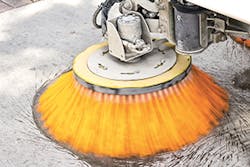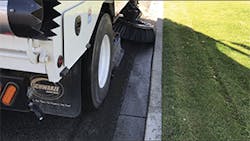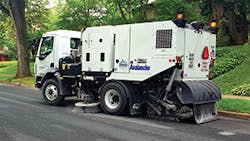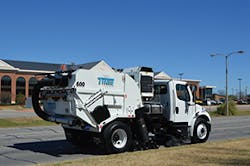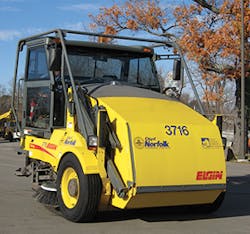In 2013, the Ada County Highway District (ACHD) in Idaho received a National Pollutant Discharge Elimination System (NPDES) Phase I permit. The shared permit authorizes stormwater discharge for the cities of Boise and Garden City.
“The City of Boise and ACHD are two of the six permitees under the Boise/Garden City area MS4 Phase I permit,” explains Monica Lowe, stormwater coordinator for ACHD. “While there are some shared responsibilities among the permitees, each entity has their own jurisdiction, responsibilities, and programs to maintain their portion of the MS4. ACHD owns and operates approximately 2,924 center lane miles of roads and streets in Ada County.”
As one of the six permitees, Boise is responsible under its stormwater program for several specific responsibilities. “Boise’s main focus, first and foremost, is permit compliance,” says Steve Hubble, stormwater coordinator for the City of Boise. “The city is the lead for public education and outreach, and another area for us is coordinating with all the other agencies.”
The other agencies Hubble refers to include ACHD, Boise State University, Garden City, Ada County Drainage District #3, and the Idaho Transportation Department District #3.
“ACHD was established in 1972 as an independent government entity and is responsible for all short-range plans, construction, maintenance, operations, rehabilitation, and improvement to Ada County’s urban streets, rural roadways (excluding state highways), and bridges,” explains Lowe. “ACHD’s jurisdiction includes Boise, Eagle, Garden City, Kuna, Meridian, and the unincorporated areas of Ada County; it is the only consolidated county highway district in the State of Idaho.”
Drainage from commercial areas falls under the City of Boise’s jurisdiction, as well as operation and maintenance of drainage conveyance systems for stream flows from main gulches in the Boise Foothills, including Cottonwood Creek, Hulls Gulch, Crane Creek, and Sand Creek.
In its responsibility to administer the NPDES permit, ACHD implements various programs aimed at keeping water from flowing across main roads and managing traffic safely. The permit charges ACHD with the responsibility of moving that water from the roads into the storm drain system, and says that it be clean before entering recreational waters like the Boise River. ACHD’s commitment to clean and improved water quality is demonstrated through its stormwater management programs, including illicit discharge detection and elimination, erosion and sediment control, stormwater monitoring investigation and monitoring of dry-weather flows, outfall inventory and inspection, and promoting green stormwater infrastructure.
“Public education and outreach is one of our biggest priorities,” emphasizes Hubble. “Success for the City of Boise is stormwater control on land development, in construction—new development. Onsite retention promotes water quality through infiltration, and most of our city’s soils are well drained and have good infiltration.”
Through its public education and outreach program, the city has developed a good materials management program that collects used oil, old pesticides and herbicides, and pharmaceuticals throughout the area. Part of that program includes a large composting effort in the city.
ACHD developed its storm drain inspection and cleaning plan in 2016. The current inventory includes 11,591 catch basins and 2,265 sediment/combination boxes within the permit area. These all fall into the inspection and maintenance rotations. The Mobile311 tracking app allows Phase I and Phase II areas to be followed separately.
The sweeping management plan was developed in 2015; it details the current street sweeping duties, including maps, sweeping routes, organizational roles and responsibilities, and waste management. Additionally, the plan helps ACHD stay on track for effective evaluations and equipment inventory for the street sweeping program.
“Throughout Ada County, a total of 34,489 curb miles were swept, resulting in the removal of 61,333 cubic yards of debris from the roadways in regularly scheduled sweeping routes during permit year 2016–17,” notes Lowe.
Which streets were swept and when is monitored with the Automatic Vehicle Location (AVL) system used by ACHD.
“ACHD’s sweeping schedule is based on the requirements in our NPDES Phase I MS4 Permit,” says Lowe. “Downtown areas are swept every other week, arterial and collector roadways are swept every six weeks, and residential roadways are swept four times a year.”
Currently in Ada County, the sweeping crew uses 22 street sweeping machines of different models for street cleaning. Schwarze A8 Twister sweepers are used on the arterial and collector roadways, Lowe notes. The residential streets get cleaned with an Elgin Eagle mechanical sweeper. Boise has a large percentage of deciduous trees that drop leaves and flowers at different times. Sweepers therefore sweep all year, picking up the debris from trees in spring and fall and salt and sand during the winter months.
“The Boise north end has many mature trees, and it’s difficult to effectively sweep without sweeping along the curb,” says Lowe. “We choose the equipment we believe we need at the time. Brooms are frequently changing. This equipment has high turnover, so we may move from one brand to another. The make and model selection process has improved with the willingness of manufacturers to let us trial new equipment. Our operator and mechanic will test functionality and assess the long-term maintenance to factor into the decision.”
Hubble, whose background includes environmental policy work in Virginia, says one of the challenges the city faces is traffic or parked cars for the sweepers to negotiate.
Lowe agrees with that assessment. “The biggest challenge is traffic and parking areas. When cars are parked against the curb, the roadway can’t be swept in its entirety. Sweeping is limited on certain roadways depending on the time of day due to high traffic volume. The motoring public often tries to maneuver around the slower-moving sweepers, which can be dangerous.”
The stormwater programs for both the City of Boise and ACHD are funded through their respective general funds. Hubble says the city has no stormwater utility fees.
Lowe explains, “Ada County does not have a stormwater utility or designated funding source for stormwater compliance. Sweeping constitutes over half of the overall ACHD NPDES Phase I permit expenditures each year. Combined storm drain system cleaning and street sweeping make up approximately 75% of the overall expenditures dedicated to meeting the requirements of the permit.”
Tymco Model 600
Hubble notes that Boise is currently in the renewal process for its NPDES permit, and tracking the changes that will come with that renewal is where the city is currently focusing its priorities.
As part of the public outreach and education program, the ACHD Maintenance Department recently held a sweeper art contest for students grades 6 through 12. “This contest solicited students to create art for a public service announcement, ‘What goes down the drain goes to the river!’” explains Lowe. “Winners had their art work placed on the sides of the sweepers. Of 55 entries received, five students had their designs displayed on an ACHD sweeper and an equipment display showcasing their art and were awarded a gift card.”
North Bergen, NJ
Across the country in North Bergen, NJ, Javier Gomez says he deals with litter and trash every day. “People just love to litter,” says the Department of Public Works head mechanic. “They know here that the sweeper will pick it up. Those plastic water bottles are probably the worst, but the McDonald’s wrappers and Starbucks cups—they all play into it.”
North Bergen is a township in Hudson County, located on the Hudson Palisades, and is considered to be one of the hilliest municipalities in the US outside San Francisco. It has a high population density of 62,886 residents in a land area measuring a little over 5 square miles.
“Our topography is a real challenge,” he says. “You need to have a vacuum truck. We had a lot of snow in 1996, and that ice was a lot of fun on these hills. Try driving 30 tons of metal on that ice! And our people, the North Bergen people, are so spoiled. We’re out there in the vacuum truck working on the road, and where are they? They’re walking in the street because their driveways are too icy.”
But Gomez says all of this with a sense of humor. He loves North Bergen and is proud of the work he does there. The city made a YouTube video of that 1996 winter storm with all the snow and ice, titled “Riders in the Storm.”
Gomez, who previously worked for Tymco, notes that North Bergen has seven Tymco machines used for street sweeping and a vacuum truck used by the Sewer Department.
“I maintain that Tymco, it picks up everything,” he says. “We replace the brooms about monthly, because they slowly wear down. They’re about 11 inches long, but when they’re down to about four, its time to replace it. You can tell when it’s time.”
He adds, “We have an older Tymco, one that’s a 1998 model. I keep them efficient, like they just rolled off the lot. I really think keeping up on the maintenance must be saving some tax dollars, right?”
When it comes to pollutants other than debris, Gomez says North Bergen doesn’t have a lot to worry about. There are not many cars for the size of the population, so grease and oil isn’t a big problem, and dog waste stations are located throughout the city, so owners have bags and a disposal receptacle at hand.
“But if someone does have an oil spill or leak, they can just call us and we’ll go out,” he adds. “We’ll go and put some Speedi-Dri down and then clean it all up and it’s gone.”
The city used to sweep only on weekdays. “But then people saw the streets all magically clean, and they like that—makes them feel good. We went to sweeping on weekends too. And I’ve been doing it now for 16 years!”
One of Norfolk’s Elgin sweepers
The City of Norfolk and the Chesapeake Bay
The first official city seal for Norfolk was presented to the Norfolk Borough by Samuel Smith in 1740. Several decades later, the final seal was presented with the legend “Et terra et mare divitiae tuae” over a sailing ship and the motto “Crescas” under sheaves of wheat. Translated, the legend reads “Both by land and by sea thy riches (are),” and the motto reads “Thou shalt grow.”
And grow it did. The population of Norfolk is currently 247,189, making it the second-largest city in Virginia, behind only Virginia Beach in population. The total area of 96 square miles is roughly half land and half water; land comprises 54 square miles and water 42. The city is located right at the junction of the Elizabeth River and Chesapeake Bay. Water is of paramount importance around Norfolk, with every drop being a valued commodity. The city is also quite vulnerable to rising sea levels. The Virginia Institute of Marine Sciences estimate that, unless trends reverse, the sea around Norfolk could rise by as much as 5 1/2 feet or more by the end of the century.
“Our stormwater program focuses on flood reduction and water-quality improvement,” says June Whitehurst, environmental programs manager with the City of Norfolk Department of Public Works. “However, there are a number of co-benefits and other goals that are also addressed through the stormwater program, such as community beautification and life long learning.”
The Department of Public Works is in charge of maintenance and management as well as the daily function of the city’s stormwater systems, including ditch maintenance, lot cleanup, BMP maintenance, flood gate maintenance and operation, pump station maintenance, and street sweeping.
“The main focus of street sweeping is to remove pollutants from the streets prior to it entering the city’s stormwater system,” says Whitehurst. “This not only improves water quality, but also helps prevent flooding. In addition, it beautifies the community and reduces litter.”
The City of Norfolk is considered to have the most comprehensive street sweeping program in the Hampton Roads area. Whitehurst notes, “Per the MS4 permit requirements, the city is performing a street sweeping monitoring study in an attempt to obtain coastal plain efficiency data to be included in the Chesapeake Bay total maximum daily load model.”
Street sweepers collect material on a fixed schedule, notes Whitehurst: “once per month on secondary roads and twice a month on primary roads, and our downtown area is swept five nights a week on Sunday through Thursday nights. The frequency is determined based on traffic and pollutants.”
Operators in Norfolk sweep 1,442 miles monthly. “The city has a number of other structural and nonstructural BMPs that are included in our program, such as ponds, bioretention, structure cleaning, and education and outreach. Although street sweeping is highly technical, it has multiple co-benefits in addition to water-quality improvement. Public education and outreach makes a large impact on changing long-term behavior of our residents and businesses to prevent pollution at the source,” she says.
“The budget is not combined with any others; the stormwater budget covers the maintenance and operation of our stormwater system, including street sweeping. Eleven percent of our budget goes to the street sweeping program,” she notes.
Street sweepers that the City of Norfolk owns and maintains include 14 Elgin Pelican-NP series three-wheeled mechanical sweepers, a Tymco Model 500x regenerative air sweeper, two Global Environmental M3 (three-wheeled) mechanical sweepers, and one Dulevo mini sweeper. This fleet collects 6,682 tons of debris a year, which helps to reduce pollution overall as well as reduces flooding. The benefits from street sweeping also play a major role in meeting the environmental requirements including the Chesapeake Bay TMDL and MS4 permit compliance.
The fleet of sweepers has about 25 operators and maintenance personnel. Sweeper operators and others in the department receive internal credits for noticing and passing along information about repairs that need to be done or streetlights that are out in the neighborhoods they serve.
In addition to the city’s street sweeping program, Norfolk’s Downtown Business Center (DBC) is maintained by a dedicated team of volunteers known as the DBC Ambassadors. The Ambassadors use small Tennant sidewalk sweepers that are either walk-behind units or have a seat attached. They keep the area looking good for the downtown business community.
The township doesn’t have many major sources of pollutants. “For one, we’re not a fast food area,” says Jorge Casacuberta, director of public works for Bernards Township. “What we have around here are specialty restaurants or the mom-and-pop kind. We don’t have the same problems of other places with the bags and wrappers and water bottles thrown out.”
Bernards Township does, however, have more than 4,000 inlets, 400 outfalls, and 100 miles of storm sewers to maintain. And although it doesn’t have the larger litter problem, Casacuberta says, crews still sweep daily to target dust and debris.
The 32 employees sweep daily with either a Tymco Model 600 or a Johnston VT651. “Around here, a good 25% is in hills, and there we use a special truck with that extra power,” he adds. “We have lots of trucks—Freightliner, International. The Tymco attaches on to one of our trucks; which truck depends on what we’re out there doing.”
If it’s snowing, he says, the sweepers stay put. The township has an ordinance that prohibits parking vehicles on the streets when it’s snowing. Casacuberta says the winter routine involves clearing snow and debris from the roadways: “We salt first, and plow. Then salt and plow again, and so forth.”
He considers the stability of the catch basins to be one of his main focus points. “We have to make sure they’re structurally sound. The salt deteriorates them, so we have to really keep them up.”
Overall, the township doesn’t face some of the same challenges that larger cities do. If sweepers come across a parked car, they just drive around it and keep on going. Trees hanging too low? Slow down and go around it, and keep on going. He says the real challenges are things like maintaining staffing to clean the catch basins, trim the trees, and take care of other tasks.
“Public education is really important,” he says. “But what residents see is the street sweeping. They see their residence all clean and it makes them feel happy.”
“We take our stormwater program very seriously,” he says. “Here at Public Works, we want people to say that we really went out of our way for them, you know?”
Street Sweeping Without Mandate
Twin Falls, ID, is focusing on stormwater management tasks like mapping where outfalls are located, public education, and, yes, street sweeping.
The Twin Falls wastewater collections superintendent, Doug Gonzales, explains that the Street Department previously was in charge of what’s considered a stormwater and preventative maintenance program. That program had responsibility for catch basins and siphon drains and maintenance of storm drains. When the Wastewater Department “inherited” a combo truck from the Street Department, the stormwater program went with it.
For now, Gonzales says, he and seven operators focus on stormwater preventative maintenance. “The Street Department made zone maintenance maps, and we have the hot spots where we want those drains to stay open. And 2020 will definitely be here soon. We want to be ready for it when it gets here.” That’s when the city will come under an NPDES Phase II permit.
“We’re pretty sure it [stormwater] will become its own department,” he says. “At the Wastewater Department, we have really good communications with the Street Department. And the street sweeping program is the biggest piece of the help with stormwater.”
The city currently owns two Schwarze sweepers, one regenerative air and one mechanical. The two Pelican trucks are both mechanical three-wheelers.
The Street Department superintendent, Dean Littler, notes that the weather, more than anything else, determines the frequency of street sweeping that occurs.
“The air machines get used every day, unless it’s snow or rain,” he says. “In early spring and fall we sweep a lot of tree debris, like leaves, pods, twigs. It’s ongoing and pretty steady; leaves don’t all fall at the same time. If we don’t sweep, all the debris washes into the gutters after it rains.”
Realistically speaking, he says, some of the sweeping routes have been based on traffic. The older parts of town have more curbs and more trees. Residents like the large, deciduous trees that leaf out with large canopies in spring. But leaf drop is staggered in the fall. It’s not uncommon to get the first snow before leaves drop.
Littler says that with the investment in new streets in the subdivisions, the city is using less salt and sand during the winter. “We’re using brine and not so much sand. We don’t have to clean up all that sand in the spring.”
Maintenance on the sweepers consists of performing regular oil changes and watching their brooms for wear. Littler says crews get about 100 hours from each broom. On the Schwarze machine, the height of the broom can be adjusted for the road contour.
“We do one pass with the mechanical sweeper and then a second with the regenerative-air machine to get at those fines,” he says.
Mapping is also a big challenge for this sprawling desert town. Currently, the city has an engineering intern who is doing mapping. “Every day he’s going out with a handheld Trimble GIS unit and a Pogo. He goes to each location and gets the invert, where it drops into a coulee, and gets locations of outfalls and catch basins,” says Gonzales. “They are put into the GIS mapping so we know exactly where all the points are. It’s beneficial, the mapping, and under Phase II that’s the information they want us to have.”
